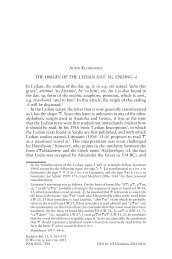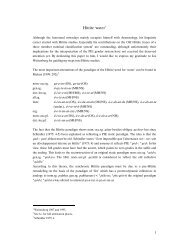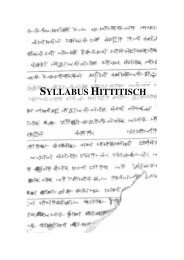The signs TA and DA in Old Hittite: evidence for a ... - Alwin Kloekhorst
The signs TA and DA in Old Hittite: evidence for a ... - Alwin Kloekhorst
The signs TA and DA in Old Hittite: evidence for a ... - Alwin Kloekhorst
- No tags were found...
You also want an ePaper? Increase the reach of your titles
YUMPU automatically turns print PDFs into web optimized ePapers that Google loves.
136Alw<strong>in</strong> <strong>Kloekhorst</strong>,<strong>The</strong> Signs <strong>TA</strong> <strong>and</strong> <strong>DA</strong> <strong>in</strong> <strong>Old</strong> <strong>Hittite</strong>mēna˘h˘hant/da < *…-h 2 ento 47šašant/di< *ssénti< *spnduti-< *spnduti-< *spndénti< *spóndei< *h 1 (e)ndo< *h 1 (e)ndomGroup 2:išpantuzziišpantuzziiãaššaršipantanzišipā˘nti/išpā˘ntiGroup 3:<strong>and</strong>a<strong>and</strong>anWe see that all words of Group 1 reflect either the PIE cluster *-nt- or the cluster *-nd h -,<strong>and</strong> that they thus contrast with the words of Group 2, which all reflect the PIE cluster*-nd-.Yet, also the two words of Group 3 that are of IE orig<strong>in</strong> are commonly reconstructedwith the cluster *-nd-. This situation is puzzl<strong>in</strong>g. If it is <strong>in</strong>deed true that the words ofGroup 2 conta<strong>in</strong> a cluster that is etymologically identical to the cluster that is present <strong>in</strong> thewords of Group 3, we would expect that synchronically <strong>in</strong> <strong>Old</strong> <strong>Hittite</strong> the two clusterswould be phonologically identical as well, <strong>and</strong> that they consequently would have beenspelled the same way. Instead, we f<strong>in</strong>d a totally opposite spell<strong>in</strong>g: consistent use of the sign<strong>TA</strong> <strong>in</strong> Group 2 vs. consistent use of the sign <strong>DA</strong> <strong>in</strong> Group 3. To my m<strong>in</strong>d, this absolute distributioncan only mean that the clusters of the two groups were phonologically dist<strong>in</strong>ct,<strong>and</strong> that, as a consequence, these clusters cannot reflect one <strong>and</strong> the same PIE cluster. Putdifferently, the consistent difference <strong>in</strong> spell<strong>in</strong>g between the two groups <strong>for</strong>ces me toassume that the reconstruction of one of these groups is <strong>in</strong>correct: the reconstruction *-ndcannotbe correct <strong>for</strong> both groups.In the words of Group 2, which are all derived from the verbal root išpā˘nt- / šipā˘nt- ‘tolibate’, the dental stop is part of that root, which on the basis of Gr. spéndw ‘to libate’ <strong>and</strong>Lat. spondeō ‘to pledge’ can securely be reconstructed as *spend-, with a *d. It is there<strong>for</strong>eimpossible to reconstruct these words otherwise than as conta<strong>in</strong><strong>in</strong>g a cluster *-nd-.In the words of Group 3, <strong>and</strong>a ‘<strong>in</strong>to’ <strong>and</strong> <strong>and</strong>an ‘<strong>in</strong>side’, the dental stop is part of a suffixthat enlarges the basic root *h 1 en- ‘<strong>in</strong>’. Although the words that are usually regarded to be47This reconstruction is based on the view that mēnah˘ h˘ ant/da must be seen as an old compound ofmēna-‘face’ + h˘ ant- ‘face, <strong>for</strong>ehead’ < *h 2 ent- (cf. <strong>Kloekhorst</strong> 2008: 576). In 2010, Nikolaev argued thatthe word is <strong>in</strong>stead a compound consist<strong>in</strong>g of the all.sg. <strong>for</strong>m of ‘face’, *men-eh 2 , <strong>and</strong> the adverb <strong>and</strong>a‘<strong>in</strong>to’. I f<strong>in</strong>d this etymology unlikely. First, the etymology dem<strong>and</strong>s that the univerbation of these twoelements must have taken place at the time that word-f<strong>in</strong>al *-eh 2 had not yet developed <strong>in</strong>to *-ā, i.e.<strong>in</strong> pre-Proto-Anatolian times already. This is to my m<strong>in</strong>d hardly credible. Second, this etymologydem<strong>and</strong>s that the Hitt. all.sg. end<strong>in</strong>g -a goes back to PIE *-eh 2 , which to my m<strong>in</strong>d is not the case:<strong>in</strong> <strong>Kloekhorst</strong> (2008: 161), I argued that it reflects *-o.Third, this etymology does not expla<strong>in</strong> whymēnah˘ h˘ ant/da shows spell<strong>in</strong>gs both with <strong>TA</strong> <strong>and</strong> with <strong>DA</strong>, whereas <strong>and</strong>a is spelled with the sign<strong>DA</strong> only. I there<strong>for</strong>e reject Nikolaev’s reconstruction, <strong>and</strong> ma<strong>in</strong>ta<strong>in</strong> that the second element ofmēnah˘ h˘ ant/da is a <strong>for</strong>m of h˘ ant- ‘<strong>for</strong>ehead’ < *h 2 ent-.






